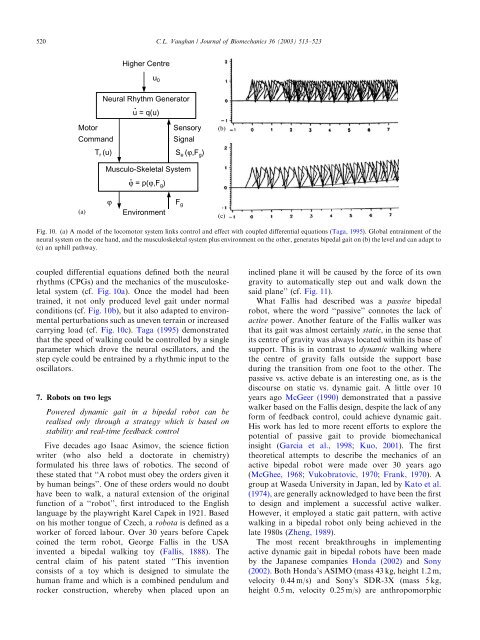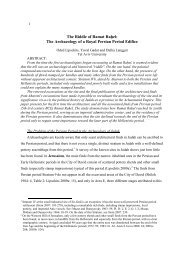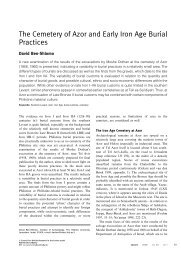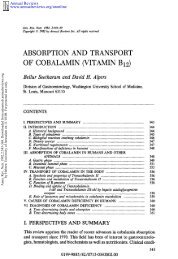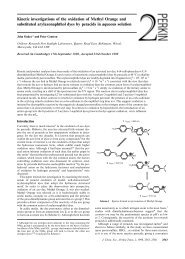Theories of bipedal walking: an odyssey
Theories of bipedal walking: an odyssey
Theories of bipedal walking: an odyssey
Create successful ePaper yourself
Turn your PDF publications into a flip-book with our unique Google optimized e-Paper software.
520C.L. Vaugh<strong>an</strong> / Journal <strong>of</strong> Biomech<strong>an</strong>ics 36 (2003) 513–523Higher Centreu 0Neural Rhythm Generator•u = q(u)MotorSensoryComm<strong>an</strong>dSignalT r (u) S e (ϕ,F g )(b)Musculo-Skeletal System•ϕ = p(ϕ,F g )(a)ϕEnvironmentF g(c)Fig. 10. (a) A model <strong>of</strong> the locomotor system links control <strong>an</strong>d effect with coupled differential equations (Taga, 1995). Global entrainment <strong>of</strong> theneural system on the one h<strong>an</strong>d, <strong>an</strong>d the musculoskeletal system plus environment on the other, generates <strong>bipedal</strong> gait on (b) the level <strong>an</strong>d c<strong>an</strong> adapt to(c) <strong>an</strong> uphill pathway.coupled differential equations defined both the neuralrhythms (CPGs) <strong>an</strong>d the mech<strong>an</strong>ics <strong>of</strong> the musculoskeletalsystem (cf. Fig. 10a). Once the model had beentrained, it not only produced level gait under normalconditions (cf. Fig. 10b), but it also adapted to environmentalperturbations such as uneven terrain or increasedcarrying load (cf. Fig. 10c). Taga (1995) demonstratedthat the speed <strong>of</strong> <strong>walking</strong> could be controlled by a singleparameter which drove the neural oscillators, <strong>an</strong>d thestep cycle could be entrained by a rhythmic input to theoscillators.7. Robots on two legsPowered dynamic gait in a <strong>bipedal</strong> robot c<strong>an</strong> berealised only through a strategy which is based onstability <strong>an</strong>d real-time feedback controlFive decades ago Isaac Asimov, the science fictionwriter (who also held a doctorate in chemistry)formulated his three laws <strong>of</strong> robotics. The second <strong>of</strong>these stated that ‘‘A robot must obey the orders given itby hum<strong>an</strong> beings’’. One <strong>of</strong> these orders would no doubthave been to walk, a natural extension <strong>of</strong> the originalfunction <strong>of</strong> a ‘‘robot’’, first introduced to the Englishl<strong>an</strong>guage by the playwright Karel Capek in 1921. Basedon his mother tongue <strong>of</strong> Czech, a robota is defined as aworker <strong>of</strong> forced labour. Over 30 years before Capekcoined the term robot, George Fallis in the USAinvented a <strong>bipedal</strong> <strong>walking</strong> toy (Fallis, 1888). Thecentral claim <strong>of</strong> his patent stated ‘‘This inventionconsists <strong>of</strong> a toy which is designed to simulate thehum<strong>an</strong> frame <strong>an</strong>d which is a combined pendulum <strong>an</strong>drocker construction, whereby when placed upon <strong>an</strong>inclined pl<strong>an</strong>e it will be caused by the force <strong>of</strong> its owngravity to automatically step out <strong>an</strong>d walk down thesaid pl<strong>an</strong>e’’ (cf. Fig. 11).What Fallis had described was a passive <strong>bipedal</strong>robot, where the word ‘‘passive’’ connotes the lack <strong>of</strong>active power. Another feature <strong>of</strong> the Fallis walker wasthat its gait was almost certainly static, in the sense thatits centre <strong>of</strong> gravity was always located within its base <strong>of</strong>support. This is in contrast to dynamic <strong>walking</strong> wherethe centre <strong>of</strong> gravity falls outside the support baseduring the tr<strong>an</strong>sition from one foot to the other. Thepassive vs. active debate is <strong>an</strong> interesting one, as is thediscourse on static vs. dynamic gait. A little over 10years ago McGeer (1990) demonstrated that a passivewalker based on the Fallis design, despite the lack <strong>of</strong> <strong>an</strong>yform <strong>of</strong> feedback control, could achieve dynamic gait.His work has led to more recent efforts to explore thepotential <strong>of</strong> passive gait to provide biomech<strong>an</strong>icalinsight (Garcia et al., 1998; Kuo, 2001). The firsttheoretical attempts to describe the mech<strong>an</strong>ics <strong>of</strong> <strong>an</strong>active <strong>bipedal</strong> robot were made over 30 years ago(McGhee, 1968; Vukobratovic, 1970; Fr<strong>an</strong>k, 1970). Agroup at Waseda University in Jap<strong>an</strong>, led by Kato et al.(1974), are generally acknowledged to have been the firstto design <strong>an</strong>d implement a successful active walker.However, it employed a static gait pattern, with active<strong>walking</strong> in a <strong>bipedal</strong> robot only being achieved in thelate 1980s (Zheng, 1989).The most recent breakthroughs in implementingactive dynamic gait in <strong>bipedal</strong> robots have been madeby the Jap<strong>an</strong>ese comp<strong>an</strong>ies Honda (2002) <strong>an</strong>d Sony(2002). Both Honda’s ASIMO (mass 43 kg, height 1.2 m,velocity 0.44 m/s) <strong>an</strong>d Sony’s SDR-3X (mass 5 kg,height 0.5 m, velocity 0.25 m/s) are <strong>an</strong>thropomorphic


